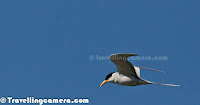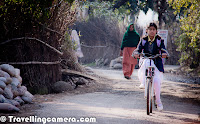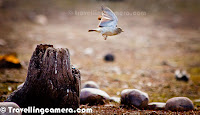Wild Wings of Pong Dam : A Series on Migratory Birds we saw at Pong Water reservoir during Winters of 2012 @ Himachal Pradesh India || PART-3
Hope you enjoyed last two parts of this series with Grey Buschat, Grey Heron, Black headed Gull, Bar Headed Goose, Ruddy Shelduck, Intermediate Egret, Little Cormorants, Little Cormorants, Little Ringed Plover, Black Kite, Black Winged Stilt, Common Sandpiper, Common Teal, Great Thicknee and Great Tit Etc. If not, just check the earlier parts @ PART-1 & PART-2 before continuing this part with more birds from Pong Dam Lake...
River Lapwing standing on single foot near Pong Dam Lake in Himachal Pradesh
The River Lapwing is a lapwing species which breeds in Southeast Asia from northeastern India to Cambodia, Thailand and Vietnam. It appears to be entirely sedentary. Formerly also called Spur-winged Lapwing... The Masked Lapwing of Australasia was at one time also called 'Spur-winged Plover', xompleting the name confusion - particularly as none of these is a plover in the strict sense...River Lapwing resembles the closely related Spur-winged Lapwing of Africa, and has sometimes been considered con-specific. The species name commemorates Alfred Duvaucel. For more details about River Lapwing, check out http://en.wikipedia.org/wiki/River_Lapwing
The River Lapwing is a lapwing species which breeds in Southeast Asia from northeastern India to Cambodia, Thailand and Vietnam. It appears to be entirely sedentary. Formerly also called Spur-winged Lapwing... The Masked Lapwing of Australasia was at one time also called 'Spur-winged Plover', xompleting the name confusion - particularly as none of these is a plover in the strict sense...River Lapwing resembles the closely related Spur-winged Lapwing of Africa, and has sometimes been considered con-specific. The species name commemorates Alfred Duvaucel. For more details about River Lapwing, check out http://en.wikipedia.org/wiki/River_Lapwing
River Tern Flying on top of Pong Dam Lake in Himachal Pradesh...
I fell in love these birds during two days of Pong Dam visit. River Terns fly amazingly on top of the water and at time flight is extremely smooth with no wing movement. Overall shape of the birds makes it better while flying. The Indian River Tern or just River Tern is actually a bird in the tern family . It is a resident breeder along inland rivers from Iran east through Pakistan into India and Myanmar to Thailand, where it is uncommon. It does not occur in Sri Lanka. Unlike most Sterna terns, it is almost exclusively found on freshwater, rarely venturing even to tidal creeks. This species breeds from March to May in colonies in less accessible areas such as sandbanks in rivers.
The bill of River Tern is yellow and the legs are red. River Tern has a black cap in breeding plumage. In the winter the cap is greyish white, flecked and streaked with black, there is a dark mask through the eye, and the tip of the bill becomes dusky.
I fell in love these birds during two days of Pong Dam visit. River Terns fly amazingly on top of the water and at time flight is extremely smooth with no wing movement. Overall shape of the birds makes it better while flying. The Indian River Tern or just River Tern is actually a bird in the tern family . It is a resident breeder along inland rivers from Iran east through Pakistan into India and Myanmar to Thailand, where it is uncommon. It does not occur in Sri Lanka. Unlike most Sterna terns, it is almost exclusively found on freshwater, rarely venturing even to tidal creeks. This species breeds from March to May in colonies in less accessible areas such as sandbanks in rivers.
The bill of River Tern is yellow and the legs are red. River Tern has a black cap in breeding plumage. In the winter the cap is greyish white, flecked and streaked with black, there is a dark mask through the eye, and the tip of the bill becomes dusky.
Northern Pintail flying from shoreline towards the lake @ Nagrota Surian, Himachal Pradesh, India
The Pintail or Northern Pintail is a widely occurring duck which breeds in the northern areas of Europe, Asia and North America. It is strongly migratory and winters south of its breeding range to the equator. This is a fairly large duck, with a long pointed tail that gives rise to the species' English and scientific names. The Northern Pintail's many names describe the male's two long black tail feathers, which in flight look like a single pin or twig. These feathers are very distinctive, accounting for a quarter of the total length of the drake when in full plumage. Fast and graceful fliers, pintails are equipped with long wings, small heads, and long necks that seem built for streamlined aerodynamics. Both sexes have blue gray bills and gray legs and feet. The drake is more striking, having a thin white stripe running from the back of its chocolate-colored head down its neck to its mostly white undercarriage. The drake also has attractive gray, brown, and black patterning on its back and sides. For more details about Northern Pintails, check out http://en.wikipedia.org/wiki/Northern_Pintail
The Pintail or Northern Pintail is a widely occurring duck which breeds in the northern areas of Europe, Asia and North America. It is strongly migratory and winters south of its breeding range to the equator. This is a fairly large duck, with a long pointed tail that gives rise to the species' English and scientific names. The Northern Pintail's many names describe the male's two long black tail feathers, which in flight look like a single pin or twig. These feathers are very distinctive, accounting for a quarter of the total length of the drake when in full plumage. Fast and graceful fliers, pintails are equipped with long wings, small heads, and long necks that seem built for streamlined aerodynamics. Both sexes have blue gray bills and gray legs and feet. The drake is more striking, having a thin white stripe running from the back of its chocolate-colored head down its neck to its mostly white undercarriage. The drake also has attractive gray, brown, and black patterning on its back and sides. For more details about Northern Pintails, check out http://en.wikipedia.org/wiki/Northern_Pintail
Northern Lapwing moving slowly during evening snacks around Pong Dam Lake in Himachal Pradesh...
The Northern Lapwing is also known as the Peewit, Green Plover or just Lapwing, is a bird in the plover family. It is common through temperate Eurasia. It is highly migratory over most of its extensive range, wintering further south as far as north Africa, northern India, Pakistan, and parts of China. Northern Lapwing migrates mainly by day, often in large flocks.
The Northern Lapwing is also known as the Peewit, Green Plover or just Lapwing, is a bird in the plover family. It is common through temperate Eurasia. It is highly migratory over most of its extensive range, wintering further south as far as north Africa, northern India, Pakistan, and parts of China. Northern Lapwing migrates mainly by day, often in large flocks.
Northern Lapwing again in some deep thoughts :)
Northern Lapwing is a wader which breeds on cultivated land and other short vegetation habitats. Three to four eggs are laid in a ground scrape. The nest and young are defended noisily and aggressively against all intruders, up to and including horses and cattle. In winter it forms huge flocks on open land, particularly arable land and muddy wetlands like Pong. More information abotu Northern Lapwings can be found at http://en.wikipedia.org/wiki/Northern_Lapwing
Northern Lapwing is a wader which breeds on cultivated land and other short vegetation habitats. Three to four eggs are laid in a ground scrape. The nest and young are defended noisily and aggressively against all intruders, up to and including horses and cattle. In winter it forms huge flocks on open land, particularly arable land and muddy wetlands like Pong. More information abotu Northern Lapwings can be found at http://en.wikipedia.org/wiki/Northern_Lapwing
Northern Pintails floating in Pong Dam Lake in Himachal Pradesh, India !
Pallas Gull @ Pong Wetland of India !
The Pallas Gull or Great Black-headed Gull is a large gull. Palas Gull has traditionally been placed in the genus Larus. Pallas Gull breeds in colonies in marshes and islands from southern Russia to Mongolia. Pallas Gull is migratory wintering in the eastern Mediterranean, Arabia and India. This gull nests on the ground, laying between two and four eggs.
Pallas Gull is a very large gull which is nearly the size of the largest Great Black-backed Gull and it is easily the world's largest black-headed gull. In all other plumage, a dark mask through the eye indicates the vestiges of the hood. The call is a deep aargh cry. Young birds attain largely grey upper parts quite rapidly, but they take four years to reach maturity. Pallas Gull birds are predatory, taking fish, crustaceans, insects and even small mammals. Check out http://en.wikipedia.org/wiki/Pallas%27s_Gull to know more about Pallas Gull !
The Pallas Gull or Great Black-headed Gull is a large gull. Palas Gull has traditionally been placed in the genus Larus. Pallas Gull breeds in colonies in marshes and islands from southern Russia to Mongolia. Pallas Gull is migratory wintering in the eastern Mediterranean, Arabia and India. This gull nests on the ground, laying between two and four eggs.
Pallas Gull is a very large gull which is nearly the size of the largest Great Black-backed Gull and it is easily the world's largest black-headed gull. In all other plumage, a dark mask through the eye indicates the vestiges of the hood. The call is a deep aargh cry. Young birds attain largely grey upper parts quite rapidly, but they take four years to reach maturity. Pallas Gull birds are predatory, taking fish, crustaceans, insects and even small mammals. Check out http://en.wikipedia.org/wiki/Pallas%27s_Gull to know more about Pallas Gull !
Pied Kingfisher flying just above the water level of Pong Dam Lake in Himachal Pradesh, India.
This is one of the birds which I liked the most through binoculars. This is also known as White Kingfisher by local folks. Pied Kingfisher looks amazing when it's sitting. I could not manage to capture Pied Kingfisher sitting :(
The Pied Kingfisher is a water kingfisher and is found widely distributed across Africa and Asia. Their black and white plumage, crest and the habit of hovering over clear lakes and rivers before diving for fish makes it distinctive. Males have a double band across the breast while females have a single gorget that is often broken in the middle. They are usually found in pairs or small family parties. When perched, they often bob their head and flick up their tail. More information about Pied Kingfisher can be checked at - http://en.wikipedia.org/wiki/Pied_Kingfisher
This is one of the birds which I liked the most through binoculars. This is also known as White Kingfisher by local folks. Pied Kingfisher looks amazing when it's sitting. I could not manage to capture Pied Kingfisher sitting :(
The Pied Kingfisher is a water kingfisher and is found widely distributed across Africa and Asia. Their black and white plumage, crest and the habit of hovering over clear lakes and rivers before diving for fish makes it distinctive. Males have a double band across the breast while females have a single gorget that is often broken in the middle. They are usually found in pairs or small family parties. When perched, they often bob their head and flick up their tail. More information about Pied Kingfisher can be checked at - http://en.wikipedia.org/wiki/Pied_Kingfisher
A flying Red Wattled Lapwing near agricultural land around Pong Dam Lake in Nagrota Surian.
The Red-wattled Lapwing is a lapwing or large plover which is a wader in the family Charadriidae. It has characteristic loud alarm calls which are variously rendered as did he do it or pity to do it leading to colloquial names like the did-he-do-it bird. Usually seen in pairs or small groups not far from water but may form large flocks in the non-breeding season, which is winter. For more about Red Wattled Lapwing check out - http://en.wikipedia.org/wiki/Red-wattled_Lapwing
The Red-wattled Lapwing is a lapwing or large plover which is a wader in the family Charadriidae. It has characteristic loud alarm calls which are variously rendered as did he do it or pity to do it leading to colloquial names like the did-he-do-it bird. Usually seen in pairs or small groups not far from water but may form large flocks in the non-breeding season, which is winter. For more about Red Wattled Lapwing check out - http://en.wikipedia.org/wiki/Red-wattled_Lapwing
A pair of Red Wattled Lapwings finding something to eat around Pong Dam Lake in Himachal Pradesh, India.
Another River Tern flying on top of Pong Dam Lake in Kangra region of Himalayan State...
You may Also Like Following PHOTO JOURNEYs -
Wild Wings of Pong Dam - Part 1
Bar Headed Goose @ Pong Water Reservoir, HP, India
First encounter with Ruddy Shelducks around Pong Dam Lake
Different Types of Cormorants at Pong Water Reservoir in Himachal
Ellora of Himachal Pradesh
A Photo Journey with Bird Silhouettes
A Quick Visit to Pong Dam and surrounding areas of the Lake
Sunset Moments at Pong Dam Lake in Kangra
A Photo Journey with Rural Himachal - Nagrota Surian on the bank of Pong Dam Lake.
Some Passionate Birders and Wildlife Professionals at Pong
Bird Counting Seminars at Wildlife Department, Pong Dam, Kangra, HP
Second part of the Series - 'Wild Wings of Pong Dam'
You may Also Like Following PHOTO JOURNEYs -
Wild Wings of Pong Dam - Part 1
Bar Headed Goose @ Pong Water Reservoir, HP, India
First encounter with Ruddy Shelducks around Pong Dam Lake
Different Types of Cormorants at Pong Water Reservoir in Himachal
Ellora of Himachal Pradesh
A Photo Journey with Bird Silhouettes
A Quick Visit to Pong Dam and surrounding areas of the Lake
Sunset Moments at Pong Dam Lake in Kangra
A Photo Journey with Rural Himachal - Nagrota Surian on the bank of Pong Dam Lake.
Some Passionate Birders and Wildlife Professionals at Pong
Bird Counting Seminars at Wildlife Department, Pong Dam, Kangra, HP
Second part of the Series - 'Wild Wings of Pong Dam'


























.jpg)